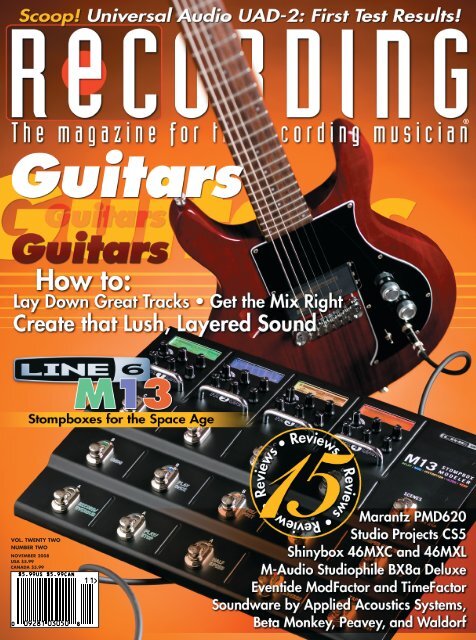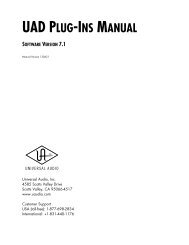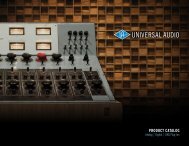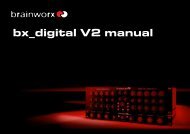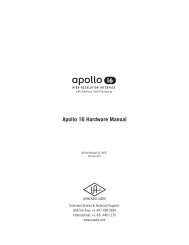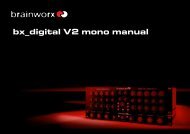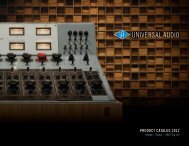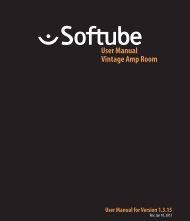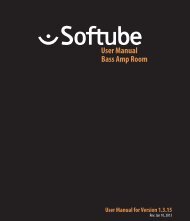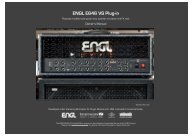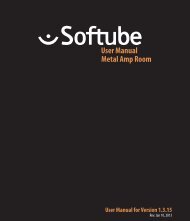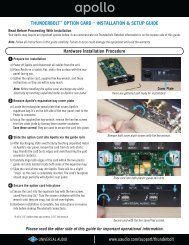You also want an ePaper? Increase the reach of your titles
YUMPU automatically turns print PDFs into web optimized ePapers that Google loves.
®<br />
VOL. TWENTY TWO<br />
NUMBER TWO<br />
NOVEMBER 2008<br />
USA $5.99<br />
CANADA $5.99<br />
$5.99US $5.99CAN<br />
11<br />
0 09281 03050 8
The version 5.0 software features a completely redesigned user<br />
interface and new features such as L.O.D.E. (dynamic plug-in load<br />
balancing) and Session Map (which maintains bi-directional session<br />
compatibility between UAD-1 and 2 equipped computers), as well<br />
as Load Lock and Live Track, both of which we will discuss below.<br />
All version 5.0 plug-ins feature a new tool bar, but are otherwise<br />
unchanged. As of this writing all but a few plug-ins have been coded and<br />
ported to the new cards, and the remaining plug-ins are in the works.<br />
B Y P A U L V N U K J R .<br />
After more rumors, speculation and wishful thinking than<br />
could be caused by a Led Zeppelin reunion tour, the wait is<br />
over! The <strong>Universal</strong> <strong>Audio</strong> UAD-2 is here, and by the time you<br />
read this, thousands will have already found homes in Macs<br />
and PCs worldwide. Some early details were published in last<br />
month’s Fast Forward, but here are our first test results.<br />
What’s new<br />
Like the original UAD-1, the UAD-2 is a DSP accelerator<br />
card and is the necessary centerpiece for running <strong>Universal</strong><br />
<strong>Audio</strong>’s Powered Plug-in system. The UAD-2 is available in<br />
three flavors: Solo, Duo and Quad, offering approximately<br />
2.5x, 5x and 10x the power of the original UAD-1.<br />
Each card is available in three bundles. All come with the Mix<br />
Essentials II plug-ins (1176SE, RealVerb Pro, the Pultec EQP-1A,<br />
and some good basic channel strip FX) and vouchers to buy more<br />
plug-ins online. The card can be bought alone with a $50 voucher<br />
(a good choice if you’re crossgrading from the UAD-1), in a<br />
Flexi package with $500 in vouchers, or in a Nevana package<br />
with $100 in vouchers plus one or more Neve plug-ins included.<br />
Also new: version 5.0 of the powered plug-in software,<br />
with increased configuration options and a snazzy new<br />
interface, and new plug-ins to follow shortly—see last<br />
month’s cover for a sneak peek at one of the new arrivals,<br />
which were mentioned in that issue’s Fast Forward.<br />
The hardware<br />
The UAD-2 is a 1x PCIe card—the Solo is a half-height<br />
short card (nice for small-form computers), and the Duo and<br />
the Quad are full-height, short cards. All three cards make<br />
use of between one and four Analog Devices SHARC processing<br />
chips for their power.<br />
As with the original, up to four cards can be used together<br />
in one computer, and the new cards can be combined<br />
with up to four original UAD-1s.<br />
The software<br />
The plug-ins come in VST and AU; Pro Tools/LE RTAS support<br />
is coming soon. They are compatible with Mac OS X<br />
10.4 and higher, and all versions of Windows XP and Vista.<br />
Meter & Control Panel<br />
Similar to the Version 4.0<br />
meter, the new one (see<br />
Figure 1) displays the DSP,<br />
Program Memory (UAD-2<br />
only), and Memory load for<br />
Fig. 1<br />
each card in the system.<br />
Large blue buttons to the left<br />
of each meter allow for quick bypass of each card.<br />
At the top of the meter is a drop-down menu that opens the UAD<br />
Control Panel with a choice of System<br />
info, Plug-in info, Configuration, and<br />
Help & Support pages.<br />
Fig. 2<br />
System Info<br />
System Info (Figure 2) displays<br />
the current software version as well<br />
as a graphic representation of each<br />
installed card. It features a numeric<br />
breakdown of each card’s power<br />
consumption and plug-in latency.<br />
On the left of each card are<br />
enable/disable buttons, which can<br />
shut off a card completely when<br />
clicked prior to loading a DAW<br />
session or if disengaged during a<br />
running session. This does not disable<br />
active plug-ins, but only keeps<br />
further plug-ins from loading.<br />
Plug-ins<br />
Plug-ins (Figure 3) shows all currently<br />
available plug-ins, and displays<br />
which ones are authorized<br />
for your cards. For those that are<br />
not, you can choose to start the<br />
Fig. 3 14-day demo mode as well as<br />
purchase and authorize plug-ins<br />
automatically from this page.<br />
If you have a UAD-1 and a UAD-2 installed, on this page you must<br />
also choose which card will run each plug-in—plug-ins cannot run on<br />
both versions of the card simultaneously. If no option for the UAD-2<br />
is present, those plug-ins have not yet been ported to the new card.<br />
The “?” Buttons are direct links to the installed PDF manual.<br />
Configuration and Help<br />
In this window (Figure 4) you will find configuration choices for both<br />
the UAD-1 and -2. The UAD-2 section starts with a DSP load limit that<br />
can be set to avoid processor overloads in your DAW.<br />
34<br />
RECORDING NOVEMBER 2008
<strong>Universal</strong> <strong>Audio</strong> UAD-2<br />
The next button, a new feature<br />
called DSP Load Lock, is<br />
best illustrated with an example:<br />
A plug-in such as the<br />
Neve 88RS channel strip is<br />
made up of individual Comp,<br />
EQ, and Filter sections.<br />
Turning these sections on or<br />
off changes its power consumption.<br />
Say you have only<br />
been using the EQ section<br />
and you engage the Filters,<br />
and your card is already<br />
maxed out by other plug-ins.<br />
You run the risk of overloading<br />
the card’s DSP. Load Lock<br />
solves this by loading each<br />
plug-in at its maximum power<br />
Fig. 4<br />
level from the start, holding<br />
DSP in reserve for when you<br />
need it. The flip side is that<br />
this can waste valuable processing power if you never use certain<br />
features of a plug-in.<br />
Another new button, Extra Buffering, adds an additional 64 buffer<br />
samples for certain DAWs such as ACID, Vegas, and SONAR to run<br />
smoothly. I tested this in ACID and it worked like a charm.<br />
The UAD-1 section of this page also adds a DSP load limit section,<br />
but is otherwise similar to the version 4.0 software. Here you<br />
can also choose how the plug-in controls respond to input data<br />
and mouse movements in your DAW.<br />
The Help & Support menu offers direct links to the UA web site.<br />
Tool bar and Live Track<br />
The new plug-in tool bar (shown in Figure 5) includes card identification<br />
(UAD-1 or 2), a help button, a direct buy link for demoed<br />
plug-ins, a new preset manager (complete with copy and paste<br />
functions), and the Live Track switch (UAD-2 only).<br />
Live Track is one<br />
of the most talked<br />
about features of the<br />
Fig. 5<br />
new UAD-2. In simple<br />
terms, Live Track<br />
lowers the internal<br />
latency of the card<br />
to an imperceptible level, allowing realtime tracking or monitoring<br />
through your favorite UA plug-ins.<br />
Installation<br />
Recording was provided with a UAD-2 Solo card just before the<br />
product line was announced, and this was forwarded to me for these<br />
tests. Since my old studio PC had no PCIe slots, and the UAD-2 is PCIe<br />
only, this review made a nice excuse for upgrading to a powerful new<br />
PC from ADK Pro <strong>Audio</strong>, my favorite music PC builder, and I installed<br />
the UAD-2 Solo into an Intel quad-core PC running Windows XP.<br />
Installation was a plug-and-play affair. Once the version 5.0 software<br />
is installed and you register for an account at uaudio.com, authorization<br />
is almost completely automated. You can also authorize your<br />
card from another computer by downloading and installing a .reg file.<br />
UAD-2 in the real world<br />
On UA’s web site (see www.uaudio.com/support/uad/<br />
charts.html) you will find a chart detailing the number of plug-in<br />
instances possible on the new UAD-2 cards, which I found to be quite<br />
accurate. On a Solo card you can get 18 stereo 1176LNs or 20<br />
mono Neve 1073s or 4 stereo Neve 33609s, and so on.<br />
Note that the “2.5 times the power” claim is a rough average.<br />
While many plug-ins manage this improvement, you may notice<br />
that other plug-ins such as the LA-2A or the Cambridge offer only<br />
slightly more instances, and a few such as the Real Verb or the EX1<br />
EQ/Comp offer the same or lower. On the flip side, other plug-ins<br />
can actually run as many as a factor of five more instances on the<br />
UAD-2. So your numbers will depend on what you use.<br />
Bust my buffers<br />
While a plug-in’s power lives on the card, the cards do have an<br />
effect on both your CPU and your sound card’s drivers. Here are<br />
my results for my ADK quad PC with a Lynx AES-16 audio interface.<br />
In Cubase 4, at a very low ASIO setting of 64 samples, I was<br />
able to load 10 stereo 1176LNs with my ASIO meter hovering<br />
around 50%. Adding more caused occasional meter spikes and<br />
audible glitches. Raising the buffer to 128 samples dropped the<br />
ASIO load to 25% and solved the glitch problem. Filling the card<br />
to its max brought the ASIO meter back to around 50% with no<br />
spikes present, but I had to be careful when adding additional<br />
native plug-ins or softsynths, lest they return.<br />
Moving to “mix-standard” settings of 512 or 1024 samples,<br />
my ASIO meter showed barely any activity above 10%, even<br />
with a full card and a host of native plug-ins.<br />
Live Tracking<br />
To test out the Live Track feature, I did some vocal, guitar<br />
and percussion passes through a mono 1176LN while monitoring<br />
through the Plate 140. I experienced zero perceptible<br />
latency. Put simply—it works. However, at an ASIO setting of 64<br />
(common for low-latency tracking), this was almost all I could run.<br />
Granted, the Plate 140 is one of the larger plug-ins. Without the<br />
reverb, I could run 5 mono 1176s each with Live Track engaged. I<br />
could also run 12 mono 1176LNs on a session, but with only two in<br />
Live Track mode, before the ASIO meter pegged out.<br />
So Live Track is fine for simple multi-channel tracking, but if you<br />
plan to overdub onto a plug-in heavy session, you may need to disable<br />
some plug-ins first. In all my tests my PC’s CPU load never<br />
exceeded 10%.<br />
Conclusion<br />
Was the UAD-2 worth the wait? In my opinion, without a<br />
doubt! The UAD-2 gives you more power with better load balancing<br />
and plug-in handling, and is a huge improvement over<br />
everything that made the UAD-1 the leader in its class.<br />
Is it right for you? Stop by UA’s web site and have a look.<br />
There are a few bugs to be worked out in some DAWs, and a<br />
few items marked “coming soon”, but in the software world this<br />
is an exceptionally complete and stable initial release.<br />
If you already own a UAD-1, you can crossgrade all of your<br />
existing plug-ins to the UAD-2 for free until the end of 2008.<br />
After that, it’s just $25 per plug-in with a cap of $250, and<br />
can be paid for with UAD vouchers.<br />
A staggering final thought: on four Quad cards, you can<br />
run 288 stereo 1176LN or 192 stereo Neve 1073 plug-ins,<br />
or... you get the idea. This is going to be fun!<br />
Prices (all MAP):<br />
UAD-2 Solo: $499 alone, $799 Flexi, $699 Nevana 32<br />
UAD-2 Duo: $899 alone, $1199 Flexi, $1499 Nevana 64<br />
UAD-2 Quad: $1499 alone, $1799 Flexi, $1999 Nevana 128<br />
More from: <strong>Universal</strong> <strong>Audio</strong>, Inc., 1700 Green Hills Road,<br />
Scotts Valley, CA 95066. 877/698-2834 (877/MY-<br />
UAUDIO), www.uaudio.com or www.uad-2.com.<br />
36<br />
RECORDING NOVEMBER 2008


